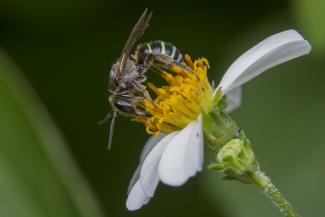
Image Credit: budak
Alfalfa Bee and relatives (Halictidae: Nomia)
The most intensively managed bee for agriculture in the Pacific Northwest (other than the honeybee) is the alkalai bee, Nomia melanderi. In the Great Basin of Oregon and Washington it is the basis for the multi-million-dollar industry for the production of alfalfa seed. More than 5,000,000 bees may service a 4-acre crop. The bees will thrive only in areas with soils that have an alkalai crust; farmers can manufacture soils like this by drilling wells that produce alkalai water and saturate the nesting areas with the required salts. The related Nomia tetrazonata is not only gregarious, but the females tend to share burrow entrances (but not the individual tunnels therein).
Nomia melanderi can be instantly recognized by its abdominal cream-colored skin bands that iridesce green. There are 9 species of Nomia in North America, all potentially generalist feeders. The related genus Dieunomia, also has 9 species in North America, all of which are specialists on the sunflower family; only 1 is likely to be found in the Oregon Great Basin.

The alkalai bee, Nomia melanderi, is instantly recognizable due to the iridescence of the yellow/white integumentary bands on the abdomen. This was the first bee species domesticated in the PNW for the production of alfalfa seed crop.